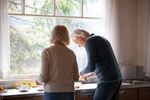EN / FR
Lifestyle Modifications
Modify your diet
Limiting the amount of caffeinated and alcoholic beverages you consume, as well as artificial sweeteners, such as aspartame, may improve your OAB symptoms. Otherwise, these ingredients can irritate the bladder and/or increase urine production.
Practice Kegel exercises
Developed by Dr. Arnold Kegel, these exercises are designed to strengthen the muscles of the pelvic floor so that the bladder is kept in place and the urethra stays shut tight.
First start doing them while lying down, then progress to doing them sitting and standing as your muscles get stronger. With your knees slightly apart, relax and find your pelvic muscles. Imagine that you are trying to hold back urine or a bowel movement. Squeeze the muscles you would use to do that. Do not do these exercises while voiding or having a bowel movement!
Tighten the muscles for 5 to 10 seconds. Make sure you keep breathing normally.
Now relax the muscles for about 10 seconds.
Repeat 12-20 times, three to five times a day.

Train your bladder
There are two basic strategies involved in bladder retraining:
1. Keeping a regular bathroom schedule, gradually increasing the time between visits.
2. Learning to suppress the urge to urinate by doing strong pelvic muscle contractions and distracting yourself with something else, like counting backwards to delay urination.
Manage your fluids
The amount of liquid you drink can affect how often you need to visit the bathroom. Drinking too much can make you go more often, which increases your risk of having an “accident”. But drinking too little isn’t good either—if you don’t stay hydrated, your kidneys may not work as well. Avoid drinking large amounts in a short period of time, but rather drink smaller amounts spread out during the day. Try to limit the amount of liquid you drink 2—4 hours before bedtime to help reduce the number of times you need to visit the bathroom at night.

Lifestyle Modifications
Modify your diet
Limiting the amount of caffeinated and alcoholic beverages you consume, as well as artificial sweeteners, such as aspartame, may improve your OAB symptoms. Otherwise, these ingredients can irritate the bladder and/or increase urine production.
Practice Kegel exercises
Developed by Dr. Arnold Kegel, these exercises are designed to strengthen the muscles of the pelvic floor so that the bladder is kept in place and the urethra stays shut tight.
First start doing them while lying down, then progress to doing them sitting and standing as your muscles get stronger. With your knees slightly apart, relax and find your pelvic muscles. Imagine that you are trying to hold back urine or a bowel movement. Squeeze the muscles you would use to do that. Do not do these exercises while voiding or having a bowel movement!
Tighten the muscles for 5 to 10 seconds. Make sure you keep breathing normally.
Now relax the muscles for about 10 seconds. Repeat 12-20 times, three to five times a day.
Train your bladder
There are two basic strategies involved in bladder retraining:
1. Keeping a regular bathroom schedule, gradually increasing the time between visits.
2. Learning to suppress the urge to urinate by doing strong pelvic muscle contractions and distracting yourself with something else, like counting backwards to delay urination.
Manage your fluids
The amount of liquid you drink can affect how often you need to visit the bathroom. Drinking too much can make you go more often, which increases your risk of having an “accident”. But drinking too little isn’t good either—if you don’t stay hydrated, your kidneys may not work as well. Avoid drinking large amounts in a short period of time, but rather drink smaller amounts spread out during the day. Try to limit the amount of liquid you drink 2—4 hours before bedtime to help reduce the number of times you need to visit the bathroom at night.
